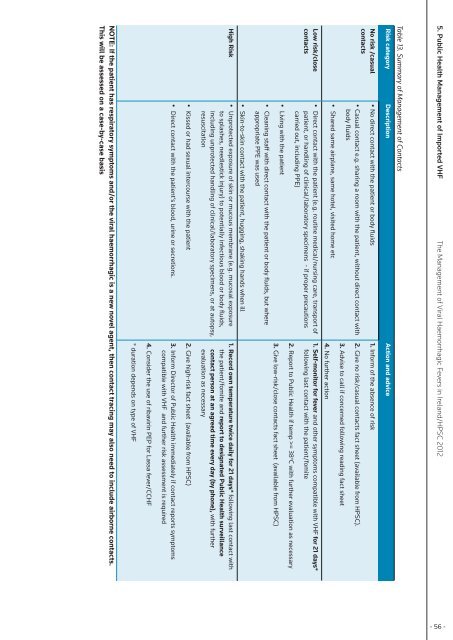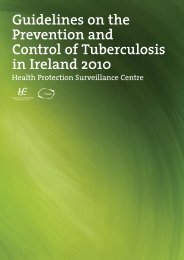The Management of Viral Haemorrhagic Fevers in Ireland - Health ...
The Management of Viral Haemorrhagic Fevers in Ireland - Health ...
The Management of Viral Haemorrhagic Fevers in Ireland - Health ...
Create successful ePaper yourself
Turn your PDF publications into a flip-book with our unique Google optimized e-Paper software.
5. Public <strong>Health</strong> <strong>Management</strong> <strong>of</strong> Imported VHF <strong>The</strong> <strong>Management</strong> <strong>of</strong> <strong>Viral</strong> <strong>Haemorrhagic</strong> <strong>Fevers</strong> <strong>in</strong> <strong>Ireland</strong>/HPSC 2012Table 13. Summary <strong>of</strong> <strong>Management</strong> <strong>of</strong> ContactsRisk category Description Action and adviceNo risk /casualcontactsLow risk/closecontacts• No direct contact with the patient or body fluids• Casual contact e.g. shar<strong>in</strong>g a room with the patient, without direct contact withbody fluids• Shared same airplane, same hotel, visited home etc• Direct contact with the patient (e.g. rout<strong>in</strong>e medical/nurs<strong>in</strong>g care, transport <strong>of</strong>patient, or handl<strong>in</strong>g <strong>of</strong> cl<strong>in</strong>ical/laboratory specimens - if proper precautionscarried out, <strong>in</strong>clud<strong>in</strong>g PPE)• Liv<strong>in</strong>g with the patient• Clean<strong>in</strong>g staff with direct contact with the patient or body fluids, but whereappropriate PPE was used1. Inform <strong>of</strong> the absence <strong>of</strong> risk2. Give no risk/casual contacts fact sheet (available from HPSC).3. Advise to call if concerned follow<strong>in</strong>g read<strong>in</strong>g fact sheet4. No further action1. Self-monitor for fever and other symptoms compatible with VHF for 21 days*follow<strong>in</strong>g last contact with the patient/fomite2. Report to Public <strong>Health</strong> if temp >= 38 o C with further evaluation as necessary3. Give low-risk/close contacts fact sheet (available from HPSC)• Sk<strong>in</strong>-to-sk<strong>in</strong> contact with the patient, hugg<strong>in</strong>g, shak<strong>in</strong>g hands when illHigh Risk • Unprotected exposure <strong>of</strong> sk<strong>in</strong> or mucous membrane (e.g. mucosal exposureto splashes, needlestick <strong>in</strong>jury) to potentially <strong>in</strong>fectious blood or body fluids,<strong>in</strong>clud<strong>in</strong>g unprotected handl<strong>in</strong>g <strong>of</strong> cl<strong>in</strong>ical/laboratory specimens, or at autopsy,resuscitation1. Record own temperature twice daily for 21 days* follow<strong>in</strong>g last contact withthe patient/fomite and report to designated Public <strong>Health</strong> surveillancecontact person at an agreed time every day (by phone), with furtherevaluation as necessary• Kissed or had sexual <strong>in</strong>tercourse with the patient2. Give high-risk fact sheet (available from HPSC)• Direct contact with the patient’s blood, ur<strong>in</strong>e or secretions.3. Inform Director <strong>of</strong> Public <strong>Health</strong> immediately if contact reports symptomscompatible with VHF and further risk assessment is required4. Consider the use <strong>of</strong> ribavir<strong>in</strong> PEP for Lassa fever/CCHF* duration depends on type <strong>of</strong> VHFNOTE: If the patient has respiratory symptoms and/or the viral haemorrhagic is a new novel agent, then contact trac<strong>in</strong>g may also need to <strong>in</strong>clude airborne contacts.This will be assessed on a case-by-case basis- 56 -
















